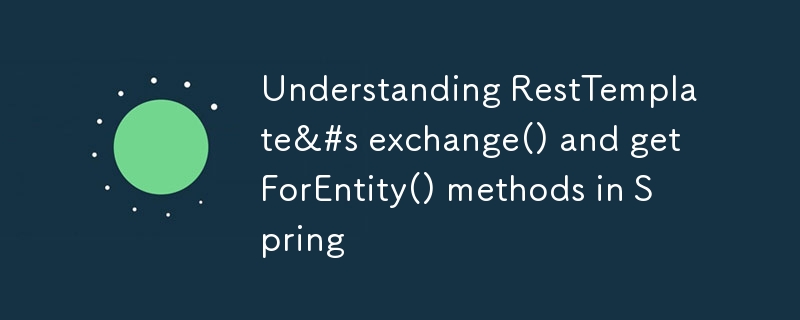了解 Spring 中 RestTemplate 的 Exchange() 和 getForEntity() 方法
- 王林原創
- 2024-08-21 20:12:30708瀏覽

在 Java Web 開發領域,使用 RESTful 服務是一種常見需求。 Spring框架提供了一個名為RestTemplate的強大工具,它簡化了發出HTTP請求的過程。在其各種方法中,exchange() 和 getForEntity() 是最常用的兩個。在本文中,我們將探討這兩種方法之間的差異、何時使用每種方法,並提供實際範例來說明它們的用法。
什麼是 RestTemplate?
RestTemplate是Spring提供的用於發出HTTP請求的同步客戶端。它抽象化了 HTTP 通訊的複雜性,並允許開發人員與 RESTful 服務無縫互動。使用 RestTemplate,您可以執行 GET、POST、PUT 和 DELETE 請求等各種操作,使其成為 Web 應用程式的多功能選擇。
Exchange() 和 getForEntity() 概述
交換()
exchange() 方法是一種更通用的方法,可以處理所有 HTTP 方法(GET、POST、PUT、DELETE 等)。它允許您指定要使用的 HTTP 方法,以及可以包含標頭和請求正文的請求實體。這種靈活性使得 Exchange() 適合廣泛的場景。
主要特點:
- 支援所有 HTTP 方法。
- 允許自訂請求標頭和正文。
- 傳回包含回應正文、狀態碼和標頭的 ResponseEntity。
getForEntity()
相較之下,getForEntity() 是專門為發出 GET 請求而設計的。它簡化了從 RESTful 服務檢索資源的過程,無需額外配置。這種方法比較簡單,非常適合只需要取得資料的場景。
主要特點:
- 專為 GET 請求而設計。
- 簡化了發出 GET 請求的過程。
- 回傳一個類似exchange()的ResponseEntity。
何時使用每種方法
使用exchange() 何時:
- 您需要執行 GET 以外的 HTTP 方法(例如 POST、PUT、DELETE)。
- 您想要隨請求一起發送額外的標頭或請求正文。
- 您需要對 HTTP 要求進行更多控制。
使用 getForEntity() 時:
- 您想要發出一個簡單的 GET 請求,無需額外的標頭或正文。
- 您喜歡更簡潔、更易讀的資料檢索方法。
實際例子
使用 Exchange() 的範例
import org.springframework.http.HttpEntity;
import org.springframework.http.HttpHeaders;
import org.springframework.http.HttpMethod;
import org.springframework.http.ResponseEntity;
import org.springframework.web.client.RestTemplate;
public class Example {
public static void main(String[] args) {
RestTemplate restTemplate = new RestTemplate();
HttpHeaders headers = new HttpHeaders();
headers.set("Authorization", "Bearer your_token_here");
HttpEntity<String> entity = new HttpEntity<>(headers);
ResponseEntity<MyResponseType> response = restTemplate.exchange(
"https://api.example.com/resource",
HttpMethod.GET,
entity,
MyResponseType.class
);
System.out.println(response.getBody());
}
}
使用 getForEntity() 的範例
import org.springframework.http.ResponseEntity;
import org.springframework.web.client.RestTemplate;
public class Example {
public static void main(String[] args) {
RestTemplate restTemplate = new RestTemplate();
ResponseEntity<MyResponseType> response = restTemplate.getForEntity(
"https://api.example.com/resource",
MyResponseType.class
);
System.out.println(response.getBody());
}
}
結論 :
總之,RestTemplate 中的 Exchange() 和 getForEntity() 方法都有不同的用途。 Exchange() 為各種 HTTP 方法和自訂選項提供了彈性,而 getForEntity() 則提供了一個簡單而有效的方法來發出 GET 請求。了解這些方法之間的差異將幫助您為您的特定用例選擇正確的方法,讓您與 RESTful 服務的互動更輕鬆、更有效率。
編碼愉快!
謝謝,
Java 憲章!
凱拉什‧尼爾瑪爾
以上是了解 Spring 中 RestTemplate 的 Exchange() 和 getForEntity() 方法的詳細內容。更多資訊請關注PHP中文網其他相關文章!

